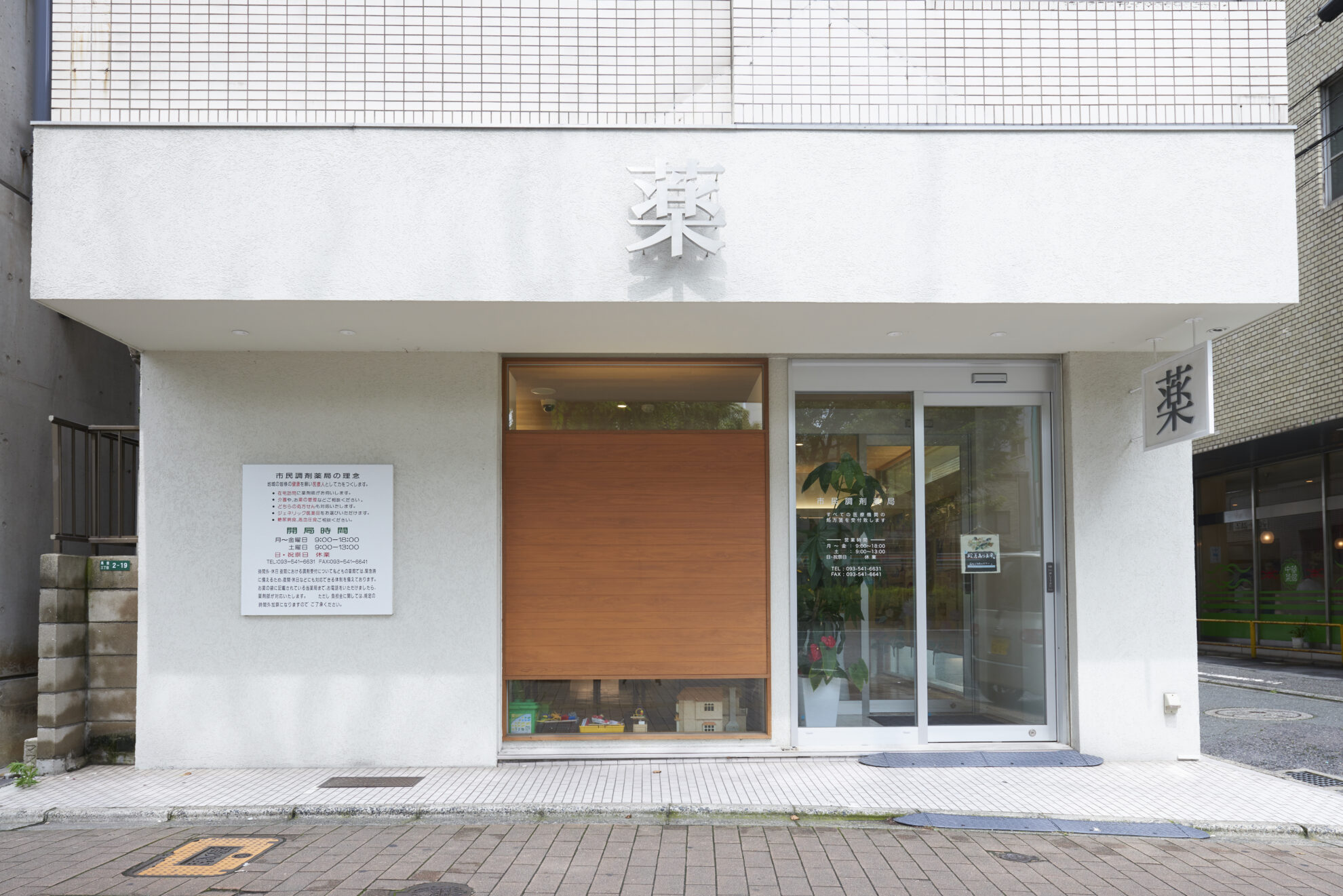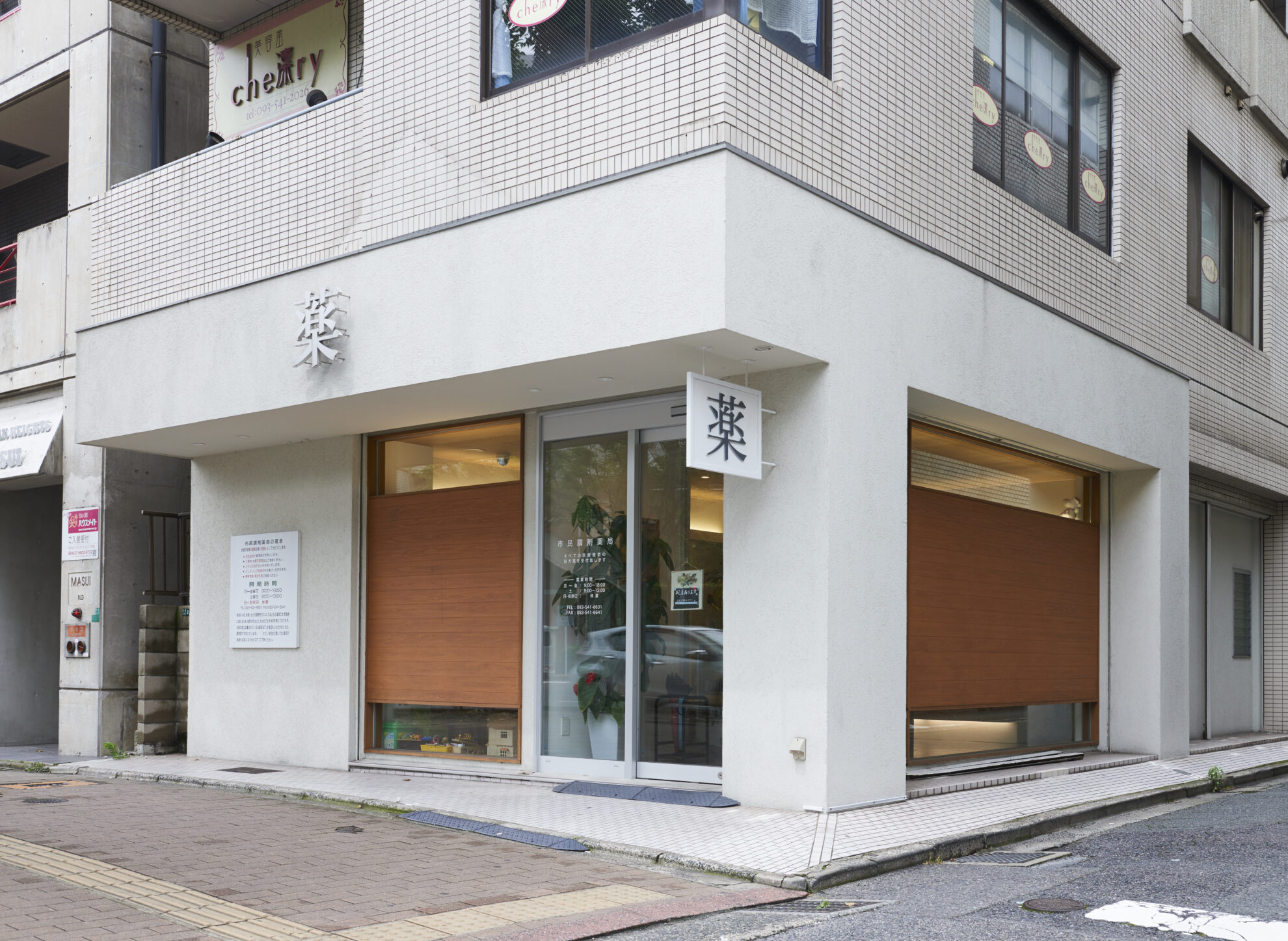- TOP
- Product
- User Reports
- Sakai Pharmacy Group (Fukuoka Prefecture)
Sakai Pharmacy Group (Fukuoka Prefecture)
Interviewees: Masao Sakai, President of Yakushindo Co., Ltd. Michiko Sakai, Senior Managing Director of Yakushindo Co., Ltd. Guest: Kenji Hazama, Chairman of The Japanese Association of Home Care Pharmacies
Interviewer (Right): Emika Matsuo, Sales Planning Department, Yuyama Co., Ltd.
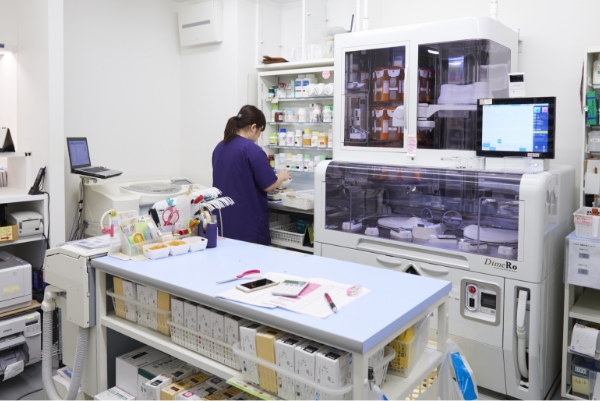
Now Staff are Saying, “We Couldn’t Live Without It.”
DimeRo Powder Drug Dispensing Robot
In November 2014, Citizen Dispensing Pharmacy of the Sakai Pharmacy Group opened a new store as a part of their relocation. The decision to purchase the DimeRo Powder Drug Dispensing Robot came after hearing about it at the Vital Signs Seminar held by the Japanese Association of Home Care Pharmacies.
We spoke with Mr. Sakai, President of Sakai Pharmacy Group, and onsite pharmacists to find out about the thoughts and opinions leading to the introduction of DimeRo and how it is currently being leveraged.
Interview with Mr. Sakai, President of Sakai Pharmacy Group DimeRo contributes to creating a comfortable working environment for females. Its speed and accuracy support female pharmacists returning to work after maternity or childcare leave.
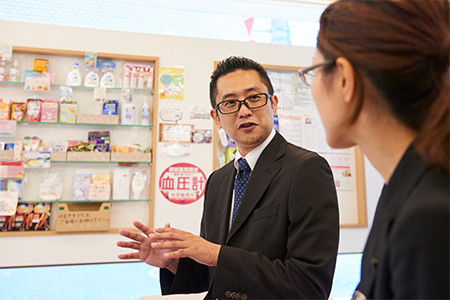
What kind of prescriptions do you receive at Citizen Dispensing Pharmacy?
We receive prescriptions from pediatrics and urology departments and deal with 120 to 150 prescriptions per day. The pediatric-to-urology (including dialysis) department ratio is 7:3, and about 60 to 70 percent of these are for powder medications.

Can you tell me about your home health care services?
We are gradually increasing the amount of home health care support we provide. At Citizen Dispensing Pharmacy, we have only about 10 private homes (about 90 as the Sakai Pharmacy Group), but our staff are eager to take on more. Handling and setting up home visits take time and effort, and we need to balance this with our other operations.
How much are you using DimeRo for dispensing powdered medicines?
We use DimeRo to dispense about 90 percent of powdered medicine prescriptions, and our pharmacists use it to package almost all powdered medicines. We only use the single-disc packaging machine for small quantity prescriptions, of 2g or less, and less common drugs that don’t meet DimeRo’s usage specifications.
※The successor models DimeRo II and MiniDimeRo (single-disk type) can dispense from 0.5g or more per drug and 0.5g or more per package.
How many types of medications have you added to DimeRo?
We currently have about 25 medications on DimeRo and two cassettes for the four most used items. We can dispense most medications here.
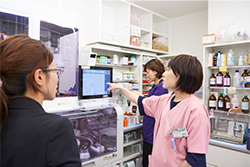
Have you used the manual window for manual dose dispensing?
We haven’t used it because it takes too much time. Manual dose dispensing is done with the packaging machine.
DimeRo allows you to check the weighing history and videos later even if you are not in front of it. How do you make use of these features?
I heard that someone used the weighing history once to confirm, but we generally don’t use it.
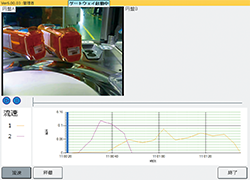
How are you leveraging DimeRo for pharmacy management?
We have many female employees and I wanted to create a workplace that is comfortable for females. I usually work behind the scenes, creating a workplace where pharmacists, admin staff, and front line workers can proactively work in the frontline is important. Female staff sometimes require time off for childbirth and I want to create a workplace that pharmacists or admin staff can return to after marriage and having children. We deal in pediatrics, and therefore having staff with experience in raising children, who can offer a word of advice or support, is helpful for our patients. Long-term leave can impact work performance and stagnate skill growth, but I think mechanization can cover these factors.

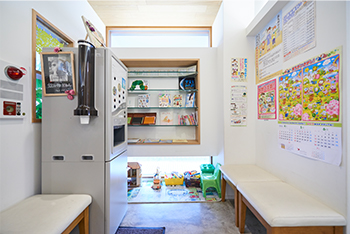
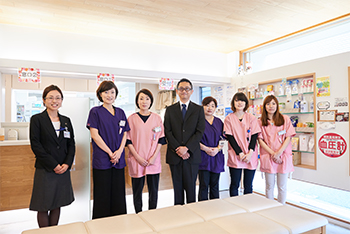
DimeRo created time for pharmacists to research, think, and improve the quality of their work.
A solution that gives us time to focus on home health care.
(Interview with Mrs. Sakai and Mr. Hazama)

How has DimeRo contributed to family practice and home health care? Today, special guest Mr. Hazama of the Japanese Association of Home Care Pharmacies, who was the driving force behind the introduction of the DimeRo, has joined us along with Mrs. Sakai of Sakai Pharmacy Group. First, can you tell us a little bit about how you talked about the DimeRo during the lecture?
When younger people see a robot like DimeRo, they’re usually excited to see it in action. Older people, however, are often lost for words or shocked that the work they have been doing for decades is now being replaced by a machine. I think they wonder, “What was the point of these last decades of work?”
The DimeRo has impacted a huge shift in thinking and things that were taken for granted are no longer being taken for granted.
I do not dispense and therefore cannot fully understand the impact but, for surgeons, I imagine it is like the advent of the laparoscope which eliminated the need for open surgery of the abdomen.
Mrs. Sakai, you seem to be right in the middle of the younger and older generations. What kind of impact did this have on you while you were still actively working?
When Mr. Hazama introduced DimeRo in his lecture, I thought, “This is it!
I enjoy dispensing medicines, so I understand it can feel hard to put the dispensing aside when there is only a limited 24 hours in a day. Some of the reasons that we couldn’t put home health care initiatives into action were notions such as “I can’t put this work aside,” “I don’t know what to do because I’ve never done it before,” or “It takes too long to prepare and hand over.” This led me to start thinking about how I could get my staff to accept the idea.
That was when I heard Mr. Hazama’s lecture and saw the DimeRo. I was excited because it seemed to be the solution to all our problems. I sat down and identified all the areas I needed to fix, thinking along the lines of “If a robot could do this then I do that.” Then I contacted Yuyama to confirm what was or wasn’t possible.
After introducing DimeRo, to help everyone understand the benefits, I took a stopwatch when everyone was working normally and measured how long it took for a human to do it versus how long it took for the robot to do it. I did this using several variables, such as work done by veteran personnel versus work completed by a novice. I was astounded by the time differences (results shown below).
When I told the results to my staff, no one believed me at first. But the results were there in writing, and I think they started to realize that helps to rely on the robot.

Prescription details measured at the Citizen Dispensing Pharmacy
・Meptin Dry Syrup 0.005%
・Mucodyne DS50%
・ONON Dry Syrup 10%
Five-day dose
Measurement Results
・Pharmacists + Packaging machine Weighing to Packaging: 4 min. to 4 min. 30 secs.
・DimeRo Prescription issuance to completion of dispensing: Approx. 3 min.
※The time required may vary depending on the environment and conditions of the measurement.
I am amazed that you could visualize so many hypotheticals. Not everyone can think along the lines of, “If I could do this, then…” and so on.
Until then, I had been thinking about what I could do. I kept imagining what would happen if certain tasks did not require a pharmacist.
It was more like DimeRo appeared at the right time and in the right place for someone who had been preparing for it. It was not just a new product discovery, it seems. It seems that you, Mrs. Sakai, were open to the new idea of a robot because you had been thinking about it for a long time. On that note, Mr. Hazama, have you been giving lectures on the robot throughout Japan?
The current situation for pharmacists is that they are too busy with the work at hand to even think about it. I believe that they do not have enough time, energy, and strength.
I think it works for pharmacies that recognize an issue and feel the need to move from distributing products to providing direct patient care. Many people are still caught up in the product-centric work in front of them. But when the costs of this style of working no longer add up, people need to start rethinking their way of doing things.
Mrs. Sakai seems more like a manager than a pharmacist. Working pharmacists tend to dislike change. When people get older, they tend to get set in their ways and react to new ideas with a simple, “Oh wow, that’s great.” She seems to have a manager’s mindset, and I think she is in the right circumstances and position to accept change.
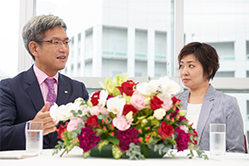
Mrs. Sakai has the combined mindset of both a business manager and a pharmacist. How do you feel after implementing DimeRo?
As I recall, you were fast to introduce it. I also heard that you broke down a wall to bring it in.
Yes, yet, I had a tough time installing it. Now that we have it, our staff members are saying, “We couldn’t live without it.” The salesperson who looked after us was very supportive and even did some detailed maintenance, which has been very helpful.
We have a lot of medical representatives (MR) living in the area and many of them have wives who are pharmacists. Our company president strives to support women in returning to their jobs are taking leave. MRs are often transferred, but we believe that if wives have the confidence to return to work, then they can continue contributing to medical care in their communities after relocating.
When a pharmacist returns to work, it can be difficult to ask veteran personnel questions during busy times. With DimeRo, veteran personnel have the time to stop inspecting and respond to returnee staff with confidence. This is reassuring to returnees.
Pharmacists are often intimidated by pediatric dispensing, but DimeRo has made it easier for people to join the company. The fact that it offers pharmacists the time to think and research, is a major advantage.
You could say that DimeRo has improved the quality of your operations, then?
Certainly. Previously we prepared the medication for evening dispensing from 2pm to 4pm while responding to outpatients. DimeRo cleared the time we used to spend on preparation. We now use that time to research home health care while responding to outpatients. Pharmacists usually use their off time to conduct research, but if you are a mother with children or you are nursing a family member, then there is not enough time for those things. Having the time to do research during work hours is important.
Do you ever think, “I wish I had a robot that could do that” or have any issues in your other stores?
A robot that could attach a separate package to one that has already been dispensed would be great. Or one that could set up a home health care calendar.
I also have a list of medication packaging papers that I wish existed. It’d be great to have light-shielding or vacuum-packed packages.
There are many innovations for packaging materials, and by thinking about what is suitable or not for the medication, we can come up with ways to change dispensing.
The best way is to see what people are doing in the field, first-hand. People have a tendency to follow procedures without question, so sometimes an outside perspective is necessary for new ideas.
I sincerely hope further mechanization will all lead to a review of the non-manual dose dispensable drugs.

Come to think of it, with the popularization of dispensing machines, many pharmaceutical manufacturers have contacted us to ask if they can feed their products through the dispensers.
Since you have taken time away from Japanese Association of Home Care Pharmacies academic conference today, can you tell us more about the status of your efforts in home health care?
Sakai Pharmacy is handling about 90 patients as a group, and Citizen Pharmacy is looking after 10 of those patients.
Home storage of patient medications tends to focus on how convenient it is for the home care workers and gives little thought to the nature of the medication. They are often placed somewhere unthinkable (to a pharmacist) such on a shelf above a heating kettle or in humid places.
One time I got a complaint from a patient saying the print on the label had rubbed off. I was shocked. However, after talking with them, I found out that the medication had been placed in the kitchen, where temperatures vary greatly, and the ink was running due to condensation and water droplets on the surface. I solved the situation by instructing them to store it in the refrigerator in a sealed pack.
Visiting the patient’s home helps us pinpoint the cause of problems or adverse pharmacological events that we couldn’t imagine from inside the pharmacy. However, this required creating a work environment that offers pharmacists the time to leave the pharmacy. And, by providing time, DimeRo has made that possible.
I’m sure a lot of things happen in home health care. Do you share such cases with other pharmacies?
The book “Pharmacological Mystery Solving of Home Care” (edited by the Japanese Association of Home Care Pharmacies, Jiho, Inc. 2016) compiles a list of real-life home patients’ situations and details how pharmacists can use a pharmacological approach to contribute to team medicine.
I can see from this book that many pharmacists are working passionately in the home health care field.
There was a time when I was thinking of quitting pharmacy because I felt it was boring. That’s when I met Mr. Hazama. Listening to his stories made me realize, for the first time, that home health care and pharmacy is a creative field
We don’t know what a patient, or their family, thinks or feels after being discharged from the hospital. Maybe they don’t want to continue with the treatment. It is our job to find out what they want. Do they want meat and potato stew, or curry, or a casserole stew? Even though with the same ingredients, as pharmacists, is it our job to think about the patient and how to best prepare it for them. In other words, it is our job to coordinate.

Coordinating with the thoughts of the patients and their families is not a job for robots, right?
That’s correct. We entrust some things to robots, but people have their strengths and that’s where a pharmacist can showcase their real abilities.
Well, thank you both for your time today.
Sakai Pharmacy Group (Fukuoka Prefecture) is such a place.
Creating a comfortable work environment for both veterans and newcomers (Citizen Dispensing Pharmacy)
Citizen Dispensing Pharmacy of the Sakai Pharmacy Group is located on the main street in the center of Kitakyushu City (Fukuoka Prefecture), a three-minute walk from Tangae Station on the monorail, which is two stops from Kokura Station. The minimalist “Medicine” sign creates a unique and refined atmosphere that makes one wonder, for a moment, “Is that really a pharmacy?”
The calm leisurely impression I got from watching the pharmacists and staff work, made me think that Mr Sakai’s vision to "make it easy for pharmacists and administrative staff to work" was being realized. Let’s hope that DimeRo will leverage the activities of people in the field.
Information as of July 2016
